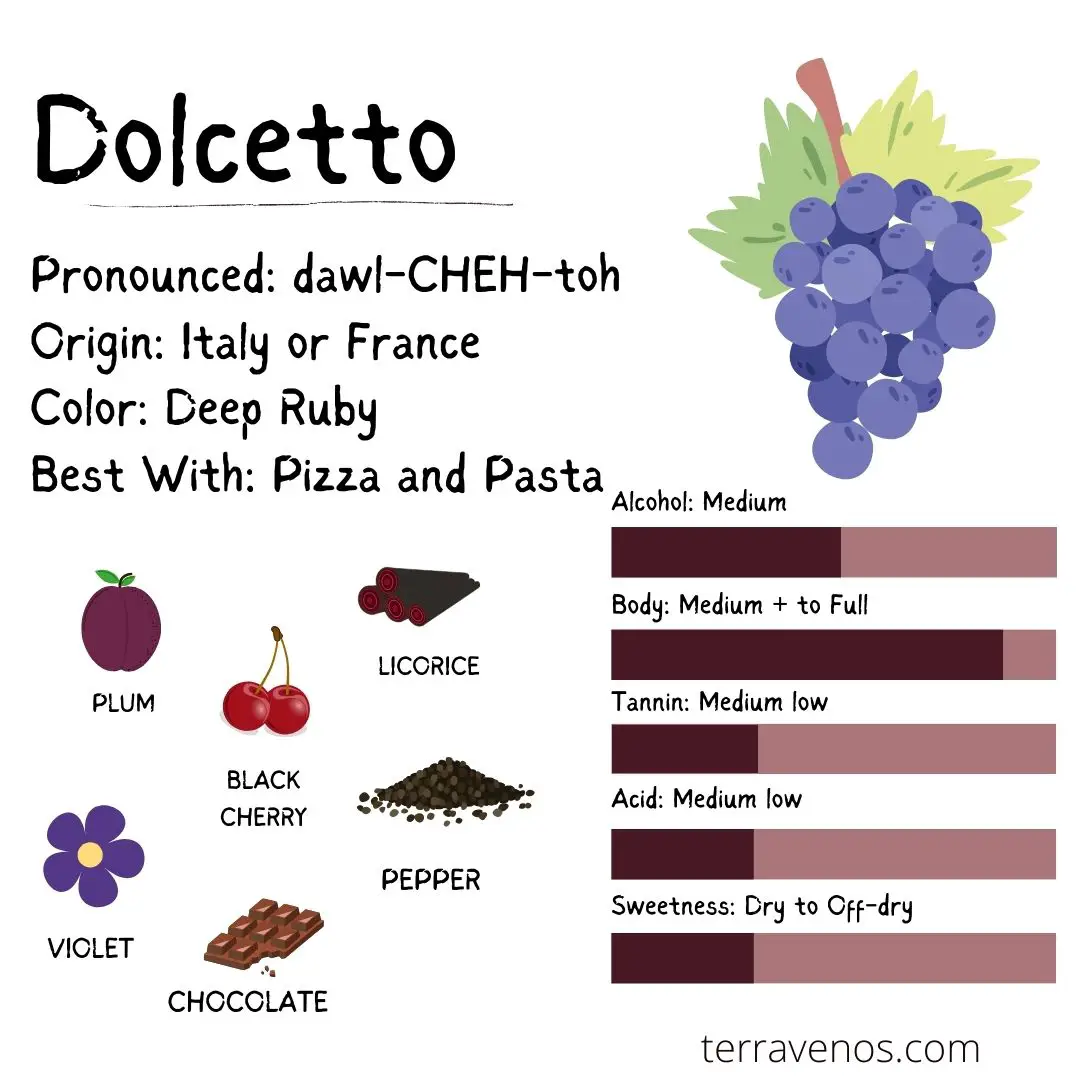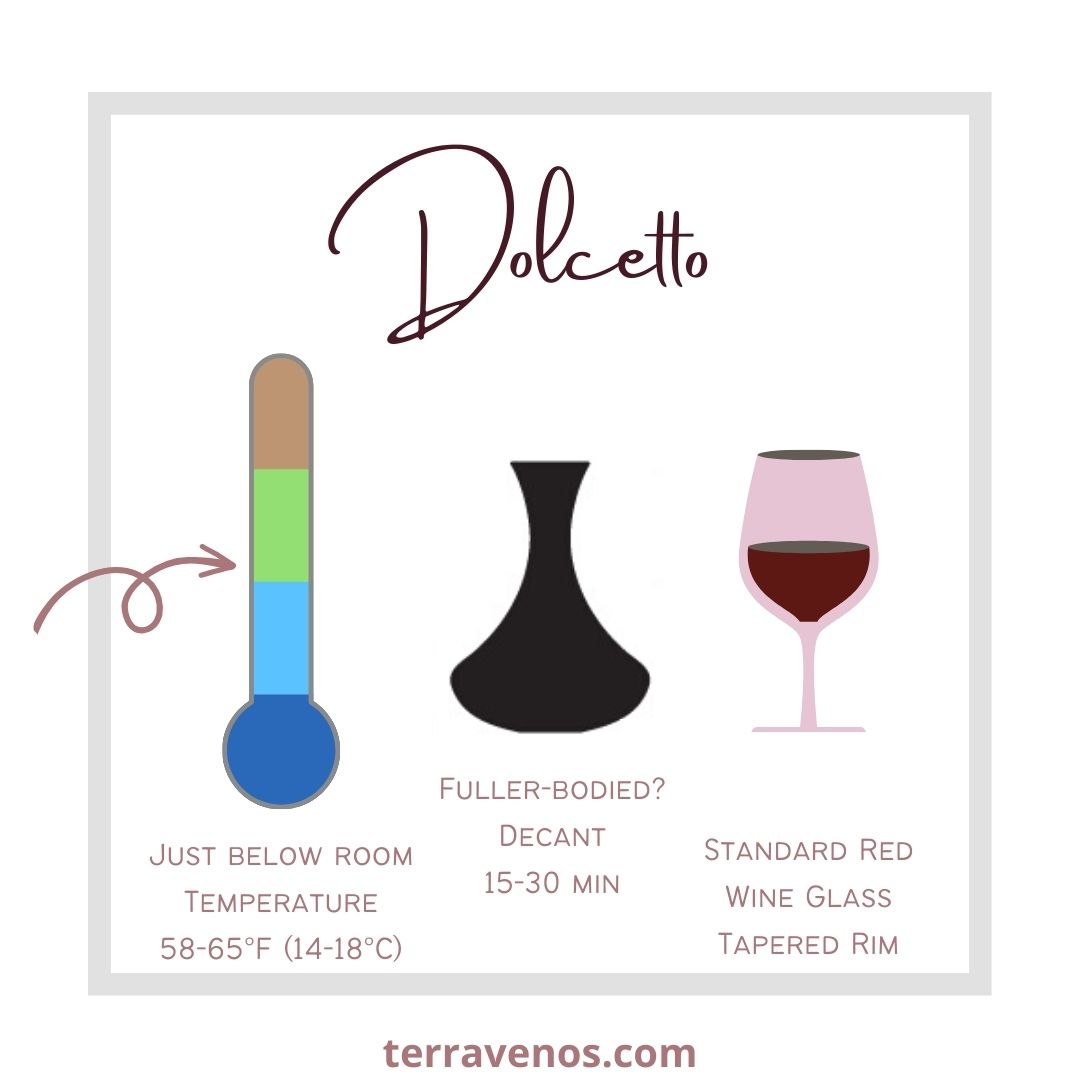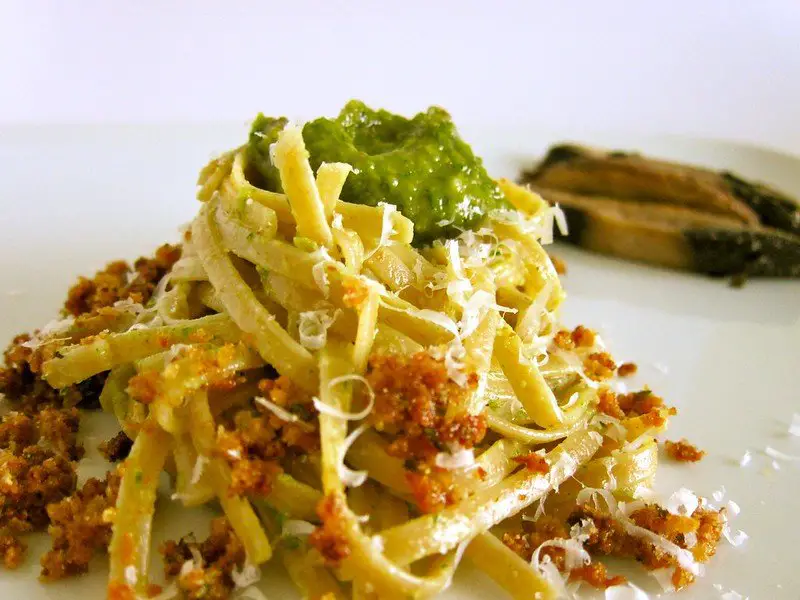
Pronunciation: dawl-CHEH-toh
Dolcetto is a red wine grape from Italy. Dolcetto makes a luscious, medium-bodied dry red wine with notes of dark berries, violet, and a hint of almond and cocoa.
- What Kind of Wine Is Dolcetto?
- Where Does Dolcetto Wine Come From?
- What Does Dolcetto Smell Like?
- What Does Dolcetto Taste Like?
- How to Serve Dolcetto Wine
- Dolcetto Synonyms
- Dolcetto Food Pairing Suggestions
- Dolcetto vs. Other Varietals
- Notable Dolcetto Producers and Bottles to Try
- Final Thoughts – Dolcetto as Must-Try Red Wine Varietal
- Thirsty for More?
What Kind of Wine Is Dolcetto?
Dolcetto is a medium-bodied red wine with moderate acidity, soft to medium tannins, and a moderate alcohol content. Positioned between lighter varietals like Barbera and more robust ones like Nebbiolo, Dolcetto offers a distinctive profile.
Where Does Dolcetto Wine Come From?
Originally from the Piedmont region in Italy, Dolcetto is deeply entrenched in the local winemaking traditions. While often overshadowed by its prestigious neighbors, Barolo and Barbaresco, Dolcetto finds its place in the diverse vineyards of Piedmont.
Dolcetto in Piedmont
In Piedmont, Dolcetto stands alongside Nebbiolo and Barbera as one of the region’s key grape varieties. While it doesn’t achieve the same fame as its counterparts, Dolcetto thrives in the region, contributing to the creation of approachable and flavorful red wines.
Dolcetto in Other Italian Regions
Outside of Piedmont, Dolcetto has found a home in various Italian regions, showcasing its adaptability. In regions like Liguria and Lombardy, winemakers craft Dolcetto wines with unique expressions, offering a delightful exploration for wine enthusiasts.
Helpful Wine Buying Tip: Look for wines labeled with Dolcetto d’Alba, Dolcetto d’Asti, or Dolcetto di Dogliani. Here’s how to use Italy’s wine classification system to get you started.
Other Notable Dolcetto Growing Regions
Beyond Italy, Dolcetto has gained recognition in certain wine regions. In places like California, Argentina, and Australia, winemakers experiment with Dolcetto, adding their own twist to this Italian classic.
What Does Dolcetto Smell Like?
Dolcetto is characterized by a charming bouquet with notes of dark berries, violet, and a subtle cocoa and spice undertone. Unlike its more tannic counterparts, Dolcetto offers a fruit-forward aroma profile, making it an inviting wine to explore.
Fun Wine Fact: Did you know that Dolcetto is sometimes referred to as “the little sweet one” due to its name, despite producing a dry wine?
What Does Dolcetto Taste Like?
Dolcetto tastes like black cherry, licorice, and bitter almond in the finish. Expect violet and hints of cocoa nibs. Dolcetto wine grapes have thick skins resulting in deeply pigmented wines with higher tannin levels. Most winemakers try to limit skin contact during winemaking to limit tannin extraction.
Helpful Tip: Explore this quick 30-second tasting tip on how to taste wine tannins.
Is Dolcetto a Heavy Wine?
Dolcetto wine isn’t typically a heavy wine and falls in the medium-bodied category. While variations exist, expect a well-balanced wine that is approachable and versatile for various occasions.
How to Serve Dolcetto Wine

Temperature
Serve Dolcetto slightly below room temperature, around 58-65°F (14-18°C). This temperature range allows the wine to express its aromatic qualities while maintaining a refreshing character.
Glassware
Choose a standard red wine glass with a slightly tapered rim and a bowl that enhances aeration. This design directs the wine’s aromas toward the nose, heightening the overall tasting experience.
Decanting
Lighter Dolcetto styles may require minimal decanting, while fuller-bodied versions benefit from 15-20 minutes to fully reveal their nuances. If you find your Dolcetto to be reserved, let it breathe for a short while before enjoying.
Aging Potential
Dolcetto is best consumed within 2-3 years of production. The wine retains its vibrant fruit flavors and develops additional complexity over this period, with dried floral notes and cocoa.
Dolcetto Synonyms
Dolcetto goes by various names across different regions. Acqui, Barbirono, Bathiolin, Batialin, Beina, Bignola, Bignona, Bignonia, Bignonina, Bourdon Noir, Cassolo, Charbonneau, Charbono, Chasselas Noir, Cote Rouge Merille, Crete de Coq, Debili Rifosk, Dolcedo Rotstieliger, Dolceto, Dolcetta Nera, Dolcetto A Raspe Verde, Dolcetto A Raspo Rosso, Dolcetto Nero, Dolcetto Piemontese, Dolchetto, Dolcino Nero, Dolciut, Dolsin, Dolsin Raro, Dolzin, Dolzino, Dosset, Gros Noir de Montelimar, Gros Plant, Maennlicher Refosco, Mauvais Noir, Montelimar, Monteuse, Montmelian, Mosciolino, Nibio, Noirin D’Espagne, Nord Du Lot Et Garonne, Ocanette, Orincasca, Ormeasca (Liguria), Picot Rouge, Plant de Calarin, Plant de Chapareillan, Plant de Moirans, Plant de Montmelian, Plant de Provence, Plant de Savoie, Plant de Turin, Plant du Roi, Premasto, Primaticcio, Primitivo Nero, Promotico, Provençal, Ravanellino, Refork, Refork Debeli, Refork Male, Refosk Debeli, Rotstieliger Dolcedo, Savoyard, Turin, Turino, Uva d’Acqui, Uva d’Acquia, Uva del Monferrato, Uva di Ovada, Uva di Roccagrimalda, and Dolsin Nero.
Helpful Tip: Outside of Italy, you’ll see Charbono and Chasselas Noir as common Dolcetto synonyms.
Dolcetto Food Pairing Suggestions

Dolcetto’s versatility makes it an excellent companion for an array of dishes. Highlight its fruitiness and tannic nature by pairing it with roasted poultry or dishes featuring earthy vegetables.
Quick Tips: Dolcetto Food Pairing
- Roast chicken or turkey with herbs
- Grilled eggplant or portobello mushrooms
- Tomato-based pasta dishes with a hint of spice
Dolcetto vs. Other Varietals
While Dolcetto shares some characteristics with its Italian counterparts, it distinguishes itself with a more fruit-forward and approachable nature. Compared to stronger grape varietals like Nebbiolo, Dolcetto offers a lighter and more easy-drinking alternative.
Dolcetto is what you drink while you’re waiting for your Nebbiolo to mellow out in the winery.
Notable Dolcetto Producers and Bottles to Try
When exploring Dolcetto, seek out producers dedicated to showcasing the grape’s unique qualities. Keep an eye on wineries known for their commitment to producing exceptional Dolcetto wines. Some noteworthy options include:
- Pio Cesare (Piedmont, Italy)
- E. Pira & Figli (Piedmont, Italy)
- Giacomo Vico (Liguria, Italy)
Here’s a lovely overview of E. Pira & Figli

Final Thoughts – Dolcetto as Must-Try Red Wine Varietal
With its enchanting dark fruit flavors, and approachable structure, Dolcetto should be in your cellar. Here are three key takeaways:
- Rich Flavor Profile: Dolcetto delights with dark berry, violet, and almond notes, creating a distinctive taste.
- Versatile Pairing: Dolcetto complements a range of dishes, from roasted meats to flavorful vegetarian options.
- Winemaking Diversity: Dolcetto will differ in style depending on the winemaker, but most will craft approachable wines ready to enjoy now.
Thirsty for More?
Planning a wine tasting? Here are finger foods for red wine.
In love with the red wines of northern Italy? Here’s the difference between Barolo and Brunello.




